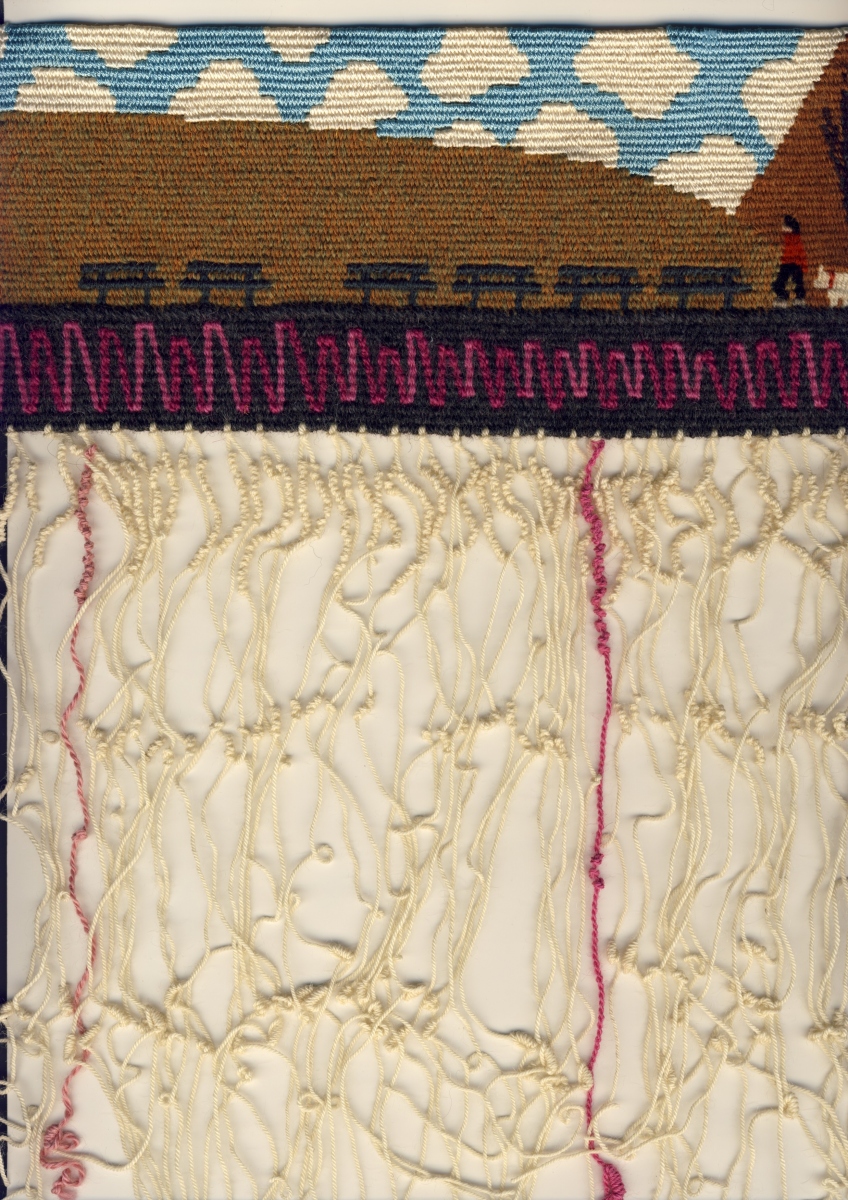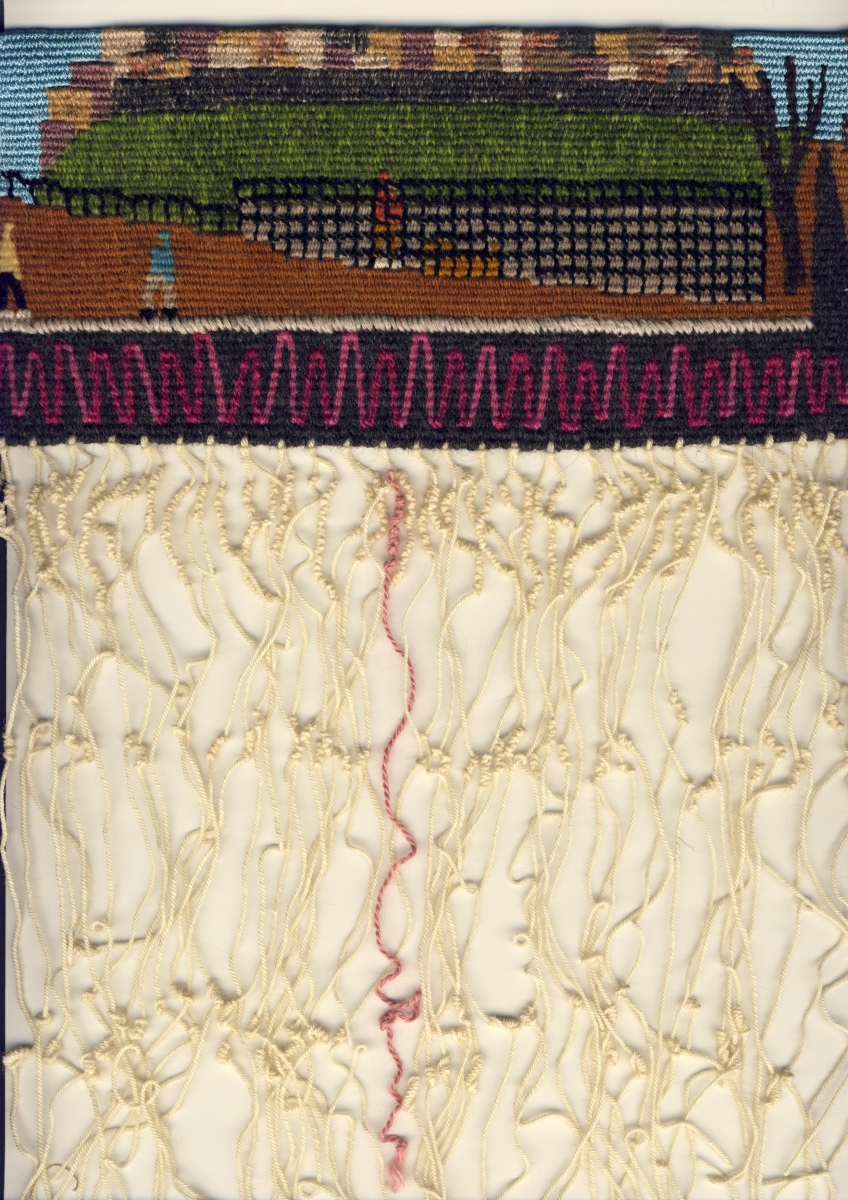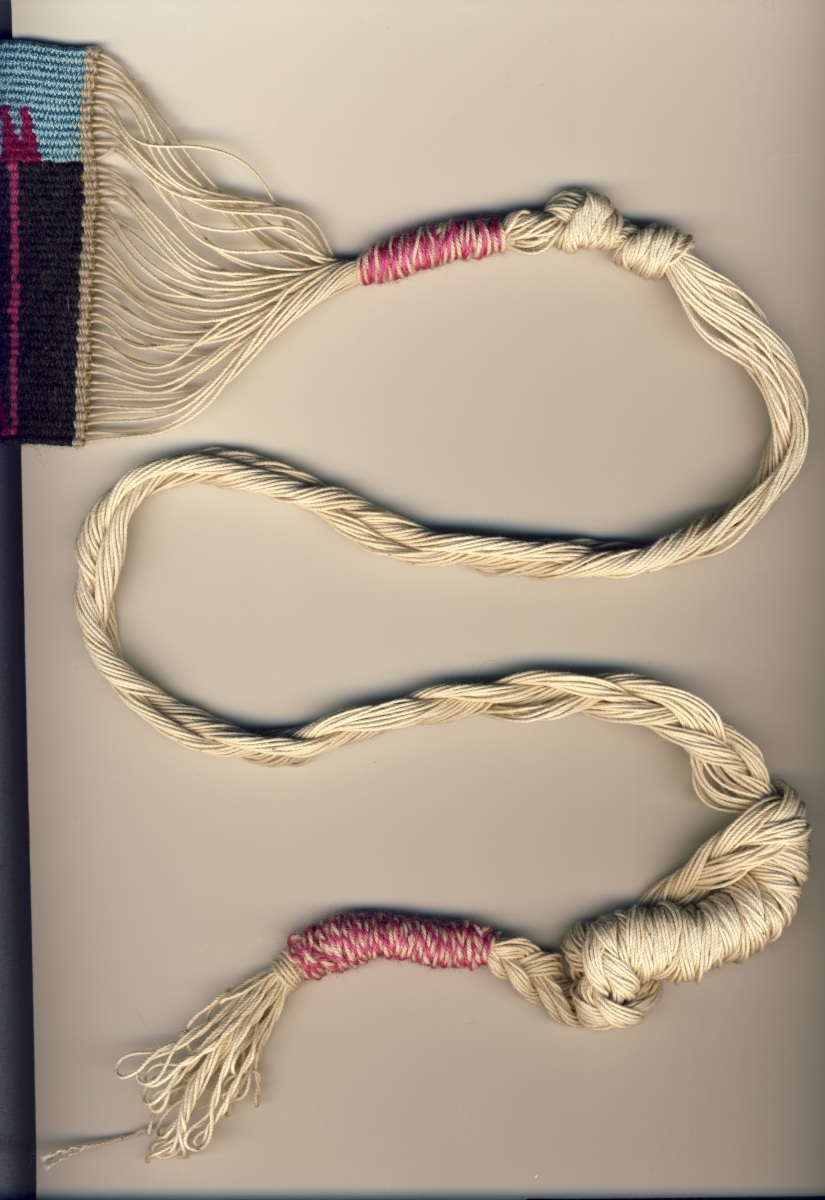Click on images and slide shows to enlarge.
“Alvia Jane”
“Alvia Jane,” 40” x 45” plus quipu and stones.
Cotton warp, wool weft & quipu.
A quipu (or khipu) is a unique communication system expressed through a spatial array of colored knotted cords. Quipus were used to record and transmit information by Andean cultures such as Huari (c. 500 – 800 CE) and Inca (c. 1400 – 1535 CE). The quipu on this tapestry, “Alvia Jane,” records the genealogy of the Disbrow and Martin families, which have each contributed their genes to Alvia Jane. The quipu is read from the middle, starting with the only salmon and white combined cord, which represents the artist. The Disbrow family (maternal descendants) is on the left and the Martin family (paternal descendants) is on the right. Direct male descendants are represented with white cords. Siblings of direct male descendants are represented with black cords for males and salmon cords for females. The two gold cords represent the artist’s grandmothers. The ply of each cord represents the gender of the ancestor, S plied for male and Z plied for female. Each generation is separated by a space on the main supporting cord. Each cord contains the year of birth and subsidiary cords contain the year of death. The dates are read from the top of the cord down and each knot represents a number. The digits are represented as a special looped knot. Some dates are missing and therefore those cords are blank.

Quipus were often found accompanied by a group of dark and light rocks. It is believed that these rocks helped the reader decipher the knots through some form of binary language. The stones accompanying “Alvia Jane” were collected from the property that has belonged to the Disbrow family for hundreds of years. They carry the names of the descendants.
“Alvia Jane,” detail, showing quipu cords
This tapestry originally began as a self-portrait. I was always told that I looked like my father’s side of the family, but the completion of the tapestry surprisingly unveiled the image of my mother. With that realization, the use of a quipu to record the ancestral links of both my mother and father was conceived.
“Nessa Nessa – Winter Moon”
“Nessa Nessa – Winter Moon”
The tapestry is mounted on a series of 28 screens arranged as an accordion book. It can be viewed in many ways – circular, accordion or stretched out to its full length, which is 252.” When closed it is a compact large book, 20″ x 9″ x 8.″ Tapestry: hand spun wool warp, indigo dyed silks, Bulgarian silks, wool, linen, hemp, cotton & metallic wefts. Mount: acid free book board, fabric, acid free Canson paper & glues.
The inspirations for “Nessa Nessa – Winter Moon” work were multiple. One was moving to a small hamlet on the Hudson River and watching the landscape change each day. Another was the eclipse of the full moon that happened to occur on my mother’s birthday, just a year after her passing. Others were my continuing interest in the quipu as a form of textile language and a recent foray into the making and history of book arts.
Nessa Nessa is a Native American song that means winter moon. The quipu hanging from the bottom of the tapestry records many facts about the Hudson River and its relationship to the moon. There is a legend to help decipher the coding. The quipu knots record the time of the rising and the setting of the moon for one year after the eclipse. The yarn colors record the moon phases. The graph at the bottom of the tapestry records the azimuth, the angle of the moon’s rising and setting. The tapestry records the possible images and weather changes that occur over a one day period in the winter. The sky records many of the major constellations and the month in which they are best viewed in the Northern Hemisphere. The song is represented by Native American flute notations and the tapestry ends with my mother’s dog Toby and I playing that song to the moon.
“Nessa Nessa – Winter Moon”
“Morning Walk & River Tides”
“Morning Walk & River Tides,” 12″ x 19.’
Cotton warp, wool, linen cotton, rami & silk weft.
The colored graph on the bottom of “Morning Walk & River Tides” records the high and low tides on the Hudson River as it passes by Inwood Park in Manhattan. The graph includes tides occurring between January 1, 2009 and January 1, 2010. Inwood Park was where I took daily walks with my dog Toby. The quipu indicates the time of each high or low tide by the knots on the white cords (read from top to bottom). Phases of the moon and the time they appear are represented by the knots on the light pink for the new moon, middle value pink for the first and last quarters and purple for the full moon. The knots on the black cords at the beginning of the scroll indicate the range of tide heights represented in the colored graph and range from –1 to +5 feet. My morning walk of approximately two miles is represented by the continuous imagery of the tapestry. Toby and I are shown near the beginning of the walk.


































